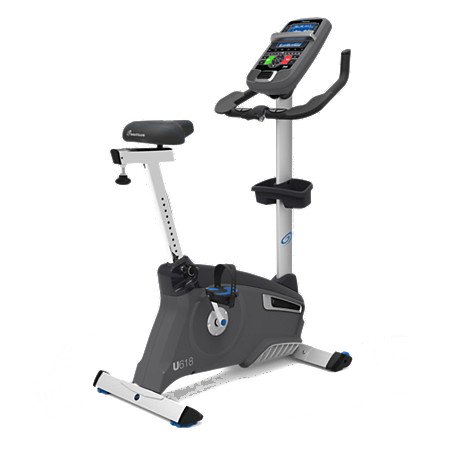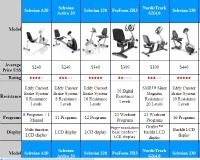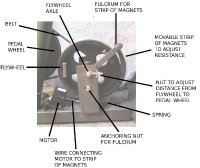Exercise Bike FAQs Answered
With so many choices, reviewing some exercise bike FAQs is often a good way to narrow down the field when trying to determine which type of bike to buy, which drive system better fits your needs, what key components to look for in a new bike, as well as many other considerations.
Below, we have included some exercise bike frequently asked questions as well as suggestions for simple repairs and maintenance steps.
What are the Types of Exercise Bikes?
There are three different styles of exercise bikes: the upright, the recumbent, and the Spin bike. There are also variations on these styles, for example, a semi-recumbent bike is a hybrid of an upright and a recumbent.
The traditional upright is the bike that most often comes to mind when people think of a stationary bike. It keeps the cyclist seated upright with the pedals just below the torso, similar to a road bike. A recumbent bike has a large bucket seat with a full backrest for lumbar support and the pedals are located out in front of the user. The modern spin bike rides like an outdoor racing bike with a small racing saddle, low set handlebars, a weighted flywheel, fixed gears, and a bike chain instead of a belt.
What Are the Different Types of Tension?
This is a common concern in exercise bike FAQs. Indoor stationary bikes use one of three types of resistance to provide tension to make pedaling harder or softer.
An upright air fan bike has a large open air flywheel where the resistance increases only when you pedal faster. Air resistance bikes don’t have adjustable resistance; you simply pedal faster to create more wind resistance and make the workout more difficult.
The second design uses mechanical resistance provided by a tension belt wrapped around a flywheel. It is adjusted with a tension knob mounted on the frame located in front of the cyclist that controls the brake pads applying pressure to the strap.
The last and most modern design uses a magnetic resistance flywheel similar to what is used on elliptical trainers. The manual magnetic brake system is adjusted with a tension knob.
On an electromagnetic resistance bike, the tension is increased or decreased electronically with the touch of a button on the console which in turn moves a magnet closer to or further away from the flywheel. Electromagnetic resistance bikes are the most expensive but they offer smooth performance and are maintenance-free.
What is the Correct Saddle Height?
This is one of the more frequent exercise bike FAQs. In short, when you sit on the saddle or seat, there should be a slight bend in your knees with you leg positioned on the bottom pedal.
What if My Bike is Too Hard or Too Easy to Pedal?
Refer to your owner’s manual to adjust the tension cable if you have a mechanical resistance bike.
Chain Drive or Belt Drive?
There are pros and cons to both chain drive and belt drive systems. A chain drive will last longer but it is noisy. It also allows for backward as well as forward pedaling. The pedals are linked to the drive system, so the pedals continue to spin until you apply the brakes. On a belt drive system, the flywheel is free spinning, so if you stop pedaling, the flywheel continues to spin independently. The belt will eventually wear out and needs to be replaced (but it is an inexpensive and easy do-it-yourself job).
What is the Difference Between an Upright and a Spin Bike?
The typical upright has a free spinning magnetic flywheel; the pedals stop moving when you stop pedaling. The upright has features such as a console, programs, and a wider more comfortable seat. A spin bike is designed to mimic a road bike. The drive system and pedals remain engaged; with the flywheel revolving, the pedals still are revolving as well. These bikes are designed for indoor cycle training, or to be used in high-intensity spin classes.
Will a Heavier Flywheel Give Better Results?
Exercise bikes do not need heavy flywheels since they only purpose the flywheel serves is to create momentum for pedaling. An 8-lb or 10-lb flywheel on an upright will be enough for most casual users. Spin bikes uses weighted flywheels that are mechanically linked to the pedals. With a flywheel of up to 44 lbs, the heavy weight provides inertia to keep the pedals revolving. Hence, the spin bike feels more like a road bike.
What About Regular Maintenance?
This is a great question to include in our exercise bike FAQs list. Most indoor bikes need very little in the way of maintenance. A chain-drive model will occasionally need to be oiled while the electromagnetic system bikes are typically maintenance free. Keep your machine clean and wipe off any sweat so that it won’t corrode exterior parts. If you do need to replace a tension belt, they are relatively inexpensive to buy and easy to switch out with a few simple tools. With a few minutes of weekly inspection and care, your bike will give you years of continuous use.
Exercise Bike Buying Guide – Finding the Right Bike at the Best Price
UPDATE: Spring Exercise Bike Sales are going on now!
Best Bikes For 2024

Best Uprights & Recumbents
Best Indoor Cycling Bikes
Best Minis/Under Desk
Comparison Charts

Upright Bikes
Recumbent Bikes
Buying Guide

Find the right bike at the best price!
Workouts

How to make the time spent exercising fun!
Submit Review

Rave or rant about the exercise bike you purchased online or used at the gym.


